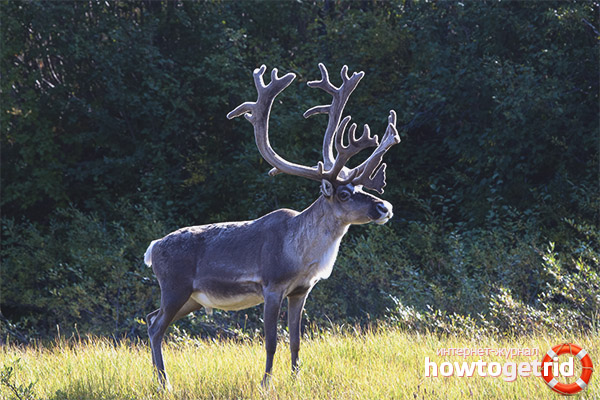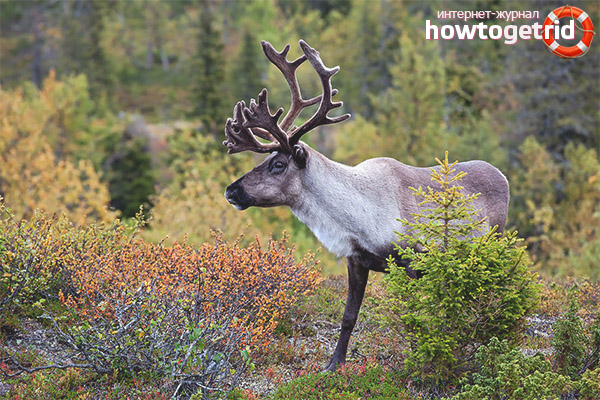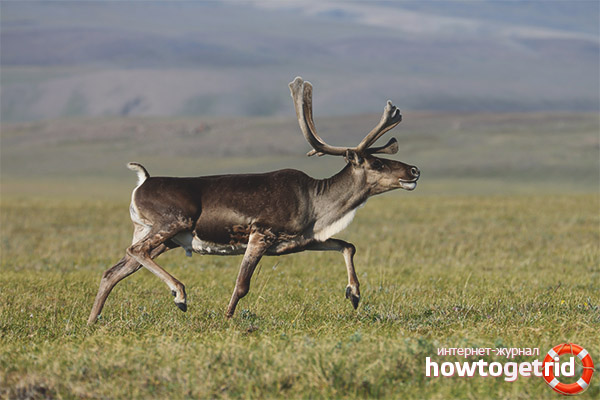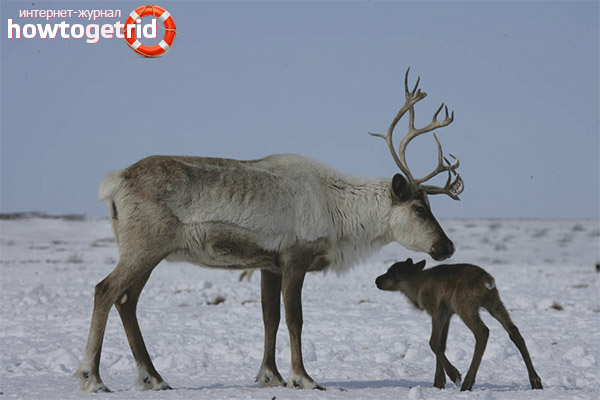The content of the article
In this article we will study the artiodactyl mammal, namely the reindeer. This animal belongs to the deer family and is distinguished by its habits and lifestyle. Residents of Eurasia and North America breed and keep deer for domestic purposes. With their help, they carry out the transportation of goods and move around themselves. Deer are very common in the tundra in the Far North, and they are also found on the Taimyr Peninsula and in other regions. But it makes no sense to run ahead, we will study all aspects in order.
Description
- Along the length of the hull, these representatives of the family extend up to 2 m with a body weight of 200 kg. In height at the withers, deer grow to 120 cm on average. Individuals living in the northern regions do not exceed the southern counterparts in their overall characteristics. Those are larger and more powerful.
- A distinctive feature of this variety can be considered the huge horns that are available for individuals of two sex supplies. Horns have a long and thick base, they first go back, then lean forward and maintain this format.
- Each year, individuals drop their horns. In males, this action occurs at the end of autumn or the beginning of winter, and in females - at the end of spring or the beginning of summer. After a certain period of time, the horns begin to grow again and reach their highest point. Other branches are already appearing on the updated horns, the format is becoming more complicated. When the animal reaches the age category of 5 years, the horns are fully formed.
- Deer are famous for their elongated and stiff mane that adorns the neck. At the same time, the hairs are fragile and break quickly, so the mane often looks groomed. The core of each hair is hollow, the shaft is absent. As for the fur, it is warm and changeable. Depending on the nutrition and season of the year, it can vary in color, being light or dark.
- Often, the color can be colorful, consisting of darkened and brightened areas. In summer, the fur is softer and shorter. The color in this period reaches a coffee or brown tone. The lateral parts of the neck with a suspension are pigmented in light. Young animals are not as dark as the adult generation. Cubs are more likely monochromatic than motley. They are either brown or gray-brown. In deer living in the southern part of Siberia, bleached large spots can flaunt on the back.
Habitat
- The main area of distribution is considered to be the tundra. Also, these individuals are found in the forest-tundra and mountainous areas. They can live in flat areas or in coniferous areas. Some choose harsh woodlands, others live closer to marshy areas.
- In winter, these individuals leave the tundra. In such a period, they prefer to live south, for example, in the taiga or forest-tundra. The herd contains about 2 thousand individuals. At first they are sorted in groups, then they are scattered in different areas and live in small colonies.
- If we talk about migration in the springtime, it is carried out slowly. Usually animals move with frequent stops for rest. Replenish energy reserves, doze off, continue the path. For 2 months, these individuals are able to overcome from 250 to 750 km.
Food
- The diet can not be called diverse due to the fact that individuals live in almost the same places. For almost their entire life, they have been extracting food from under the snow mass. And you have to overcome snowdrifts of snow to get to food. If the cover is loose, individuals dig it in the depth of 0.5-1 m. If on the surface there is an crust, then the forces will be enough to overcome only 40 cm.
- For digging up snow, individuals of male gender are first taken. They rake deposits, finding food of plant origin. Then the females in these areas feed themselves and treat offspring. At the very least, weakened animals eat.
- Deer are exposed to severe stress during the winter season, so they need more food than usual. When they feed, they do not stop for a long period. After the breakdown of grass or lichens, they continue to walk, eating along the way. This also allows the herd, going behind, also feed.
- The characteristic features of the diet include the fact that the mammals represented can assimilate the moss. They even lie on tree branches, shoots and other solid plant foods. There is almost no protein in the composition of the reindeer moss, but, nevertheless, it forms the basis of the menu.
- A huge part of the nutrients is given to silicon and other mineral compounds. Yagel is considered a high-calorie food, is digested for a long time and increases energy reserves. In the winter, these animals require protein compounds and other minerals.
- They complement the basic menu with brackish water and mushrooms that grow in cold weather. In other periods, deer spend those stocks that they managed to collect in the warm season. There is little food base in the habitat, therefore, due to migration, individuals expand it.
- Another source of food is moss. Especially often they lean on it when the season is accompanied by a lot of snow. As a rule, moss comes across by chance, it is not specifically sought. When animals need a lot of food, they lean on mice, eggs of birds and chicks.
- Representatives of the family are struggling with dehydration by consuming the snow that comes with food. They can gnaw the discarded horns in the hope of filling up the deficit in nutrients. When the season is accompanied by severe frosts without snow, these animals weaken due to lack of fluid.
Behavior
- It is worth noting an interesting fact, the presented individuals are public animals. They prefer to graze in large herds. Each can have more than 1000 individuals. When animals are about to roam, this number is greatly multiplied.
- It is noteworthy that the presented deer migrate for several decades along the same route. Moreover, the path length can be more than 500 km. Such individuals swim beautifully, so there is no problem for them to cross through straits and rivers.
- Siberian representatives of this species in winter mostly live in the forest. In late spring, deer gather in large herds and head to the tundra. It was at this time that more food was present in such places for animals. Around the end of summer or early fall, the animals in question return.
- As for the Scandinavian representatives of the species, on the contrary, they try to stay away from the forests. Caribou deer that live in North America in mid-spring move from the forest to the sea. Only in the middle of autumn do they return to their habitats.
- There is also a European look. Throughout the year, they move across the territory over short distances. In the summer, they prefer to live in the mountains. In such places it is much cooler. In addition, deer thus protect themselves from predators. In winter, they can move to another mountain or go down.
- As sad as it seemed, deer suffer greatly from gadfly. The problem is that such insects lay their eggs right under the skin of the animal. Soon abscesses develop. It is in them that the larvae begin to grow. Nasal gadflies lay eggs even in the nostrils of individuals. Thus, animals suffer greatly and are exhausted.
Breeding
- As for the mating season, the deer mainly play games in mid-autumn.Males constantly fight among themselves to win the attention of females. After mating, the couple expects offspring for about 8 months. As a rule, only 1 cub is born. Only in rare cases is twins.
- Literally a day later, the deer is already starting to run after his mother. Before winter comes, the female must feed the offspring with milk. 3 weeks after birth, the deer begin to make their way through the horns. Only in 2 years deer reach puberty. The life span of individuals is about 25 years.
Enemies
- Reindeers are predominantly hunted by large predators. The individuals in question have sufficient fat and meat. The main enemies of deer can be considered bears, wolves, lynxes and wolverines. It is during the migrations of the animals presented that hunting begins. For predators, this is the most favorable time.
- At such times, deer gather in huge herds and try to migrate over long distances. Weak and sick individuals always lag behind and fight off the herd. Weakened, they become easy prey for predators.
- Unfortunately, humans pose the greatest danger to animals. It is he who exterminates deer in huge numbers. All this happens for the meat, skin and horns of the animal. In the Northern European part, there are currently about 15 thousand individuals.
- In North America, this figure is much higher. About 600 thousand individuals live in the country represented. In the polar zone of Russia, the number of deer reaches 800 thousand. There are also domestic deer. Their number exceeds 3 million goals.
People have long domesticated reindeer. They simply isolated part of the wild herd and over time the animals adapted. As a result, individuals feel great. They are used to people, and lead a semi-free life. Deer do not run away in case of danger, but wait for protection from humans.
Video: reindeer (Rangifer tarandus)













Submit